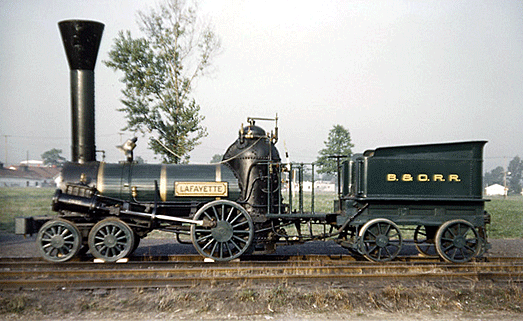First came the steam engine, itself.
Then came the steam locomotive. Both in their own way changed the
course of history.
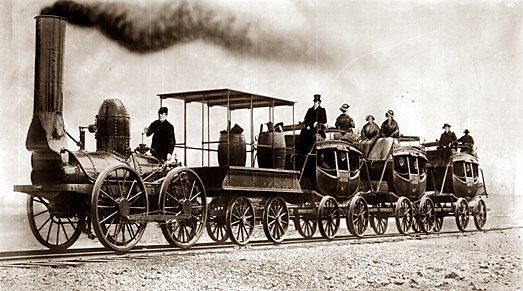
On the warm morning of August 27, 1831, a throng of people flocked
to Lydius Street in Albany, New York. They had come to see the new
railroad train. The odd-looking engine, the "De Witt Clinton," stood
in front of a tender containing water and fuel, followed by three
passenger cars, made from the bodies of stagecoaches fastened on
special railroad wheels and several flat cars to hold luggage.
Local hotels had sold tickets to ride the train. As passengers
climbed into the carriages and took their seats, a conductor,
standing on a platform outside each coach, collected the tickets,
then climbed to a seat on the tender and blew a horn. The engine
gave a great jerk, and the crowd cheered. All along the 17 miles to
Schenectady, New York, farmers and their families gathered to see
this new spectacle and wave to the passengers.
According to an eye-witness account published in the Albany Argus on
August 27, 1831, “The engine performed the entire route in less than
one hour, including stoppages, and on a part of the road its speed
was at the rate of thirty miles an hour." The train made the return
journey from Schenectady to Albany in 38 minutes, much to the
delight of its promoter.”
But the story of the steam locomotive, indeed that of the railroad,
didn’t begin in Albany. Instead, it began three decades earlier and
3,000 miles across the Atlantic in northeastern England.
The First Locomotive
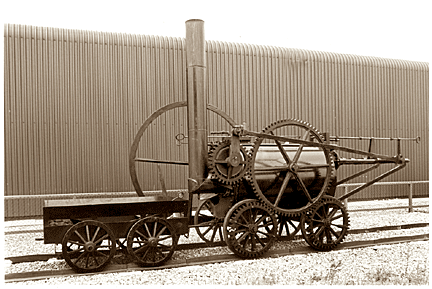 The
first successful steam locomotive was Cornishman Richard
Trevithick’s 1804 creation, which ran on an iron plateway in South
Wales. On 21 February 1804, the world's first steam-powered railway
journey took place when Trevithick's unnamed steam locomotive hauled
a train along the tramway of the Penydarren ironworks, near Merthyr
Tydfil in South Wales. But nothing much came of Trevithick’s
invention because his engines were too heavy for the cast-iron
plateway track then in use.
The
first successful steam locomotive was Cornishman Richard
Trevithick’s 1804 creation, which ran on an iron plateway in South
Wales. On 21 February 1804, the world's first steam-powered railway
journey took place when Trevithick's unnamed steam locomotive hauled
a train along the tramway of the Penydarren ironworks, near Merthyr
Tydfil in South Wales. But nothing much came of Trevithick’s
invention because his engines were too heavy for the cast-iron
plateway track then in use.
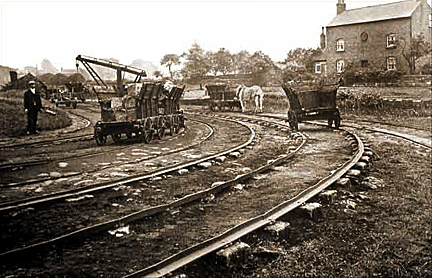
However, it was northeastern England
where lines built of wood and iron, of rails or L-shaped plates,
linking mines with wharves, gradually evolved to a point where steam
traction became not only practical but preferred.
These early primitive railways served the English coal mines,
pulling 150 tons of ore at 3 miles per hour. One of the early
enthusiasts was George Stephenson, an enginewright from the
Killingsworth Colliery.
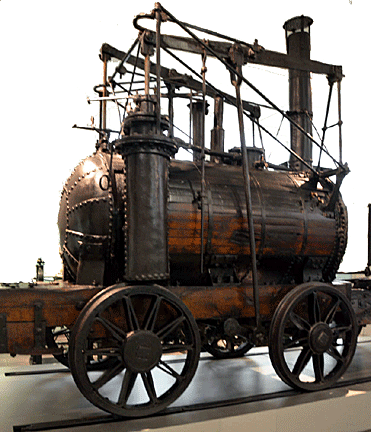 In
1814, George Stephenson, inspired by the early locomotives of
Trevithick, Murray and Hedley, persuaded the manager of the
Killingworth Colliery where he worked to allow him to build a
steam-powered machine. Stephenson played a pivotal role in the
development and widespread adoption of the steam locomotive. His
designs considerably improved on the work of the earlier pioneers.
In
1814, George Stephenson, inspired by the early locomotives of
Trevithick, Murray and Hedley, persuaded the manager of the
Killingworth Colliery where he worked to allow him to build a
steam-powered machine. Stephenson played a pivotal role in the
development and widespread adoption of the steam locomotive. His
designs considerably improved on the work of the earlier pioneers.
Stephenson built the locomotive Blücher, also a successful
flanged-wheel adhesion locomotive that could pull 50 tons of ore at
3 miles per hour, replacing 20 horses. He also surveyed and
constructed the line. The colliery management decided to build a
25-mile line from the river at Stockton to the colliery at
Darlington. And thus the first railway, the Stockton and Darlington
Railway was born. Though it began with coal, it eventually carried a
variety of freight and passengers on regularly scheduled service.
Stephenson used fish-bellied rails—deeper in the center than at the
ends—which sat on cast-iron “chairs” pinned to wooden blocks cut
from the oak timbers of warships left over at the end of the
Napoleonic Wars.
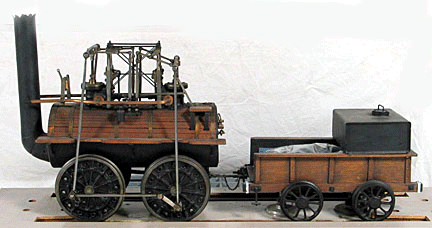
Stephenson and his son Robert built the first powerful steam
locomotive, Locomotion No 1, at Newcastle. It hauled the inaugural
train carrying 90 tons of coal at 15 miles per hour on September 27,
1825, carrying over 500 passengers, 200 more than had been expected.
The train had only two breakdowns along the way and only one
casualty when a brakeman’s leg had to be amputated en route.
His firm, Robert Stephenson and Company, soon developed a thriving
locomotive building business. The company built the Stourbridge
Lion, the first full-scale locomotive to operate on a United States
railroad, what became the Delaware and Hudson R.R.
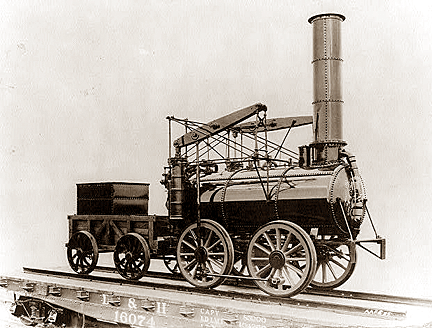
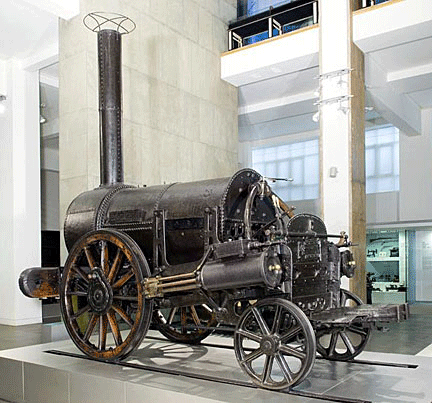 Meanwhile,
Stephenson had been appointed consulting engineer to the Liverpool
and Manchester Railway whose directors couldn’t decide whether to
use locomotive or cable traction. Those in favor of the former
suggested a competition. The competition, known as the Rainhill
Trials, occurred in 1829.There were three competitors— Stephenson
entered the Rocket, one of his successful models with the connecting
rods removed. The Rocket had an ingenious system for generating
steam—a multi-tubular boiler. Instead of passing the smoke and hot
gas from the fire through a wide flue and up the chimney, Stephenson
provided 25 3-inch copper tubes leading from the firebox, through
the waterspace of the boiler and then up the chimney. The innovation
raised more steam for the same amount of coal. He and his designer
of tube pressurized boiler received prize for 1st place, and soon
their locomotives started appearing all across England.
Meanwhile,
Stephenson had been appointed consulting engineer to the Liverpool
and Manchester Railway whose directors couldn’t decide whether to
use locomotive or cable traction. Those in favor of the former
suggested a competition. The competition, known as the Rainhill
Trials, occurred in 1829.There were three competitors— Stephenson
entered the Rocket, one of his successful models with the connecting
rods removed. The Rocket had an ingenious system for generating
steam—a multi-tubular boiler. Instead of passing the smoke and hot
gas from the fire through a wide flue and up the chimney, Stephenson
provided 25 3-inch copper tubes leading from the firebox, through
the waterspace of the boiler and then up the chimney. The innovation
raised more steam for the same amount of coal. He and his designer
of tube pressurized boiler received prize for 1st place, and soon
their locomotives started appearing all across England.
Because the other two competitors just weren’t powerful enough or
had manufacturing defects, so the Rocket won, hauling 13 tons of ore
at 29 miles per hour.
Over the years steam locomotives evolved significantly. They were
equipped with cow catchers for better moving through turns and for
protection from wandering animals on railway tracks. Passenger
travel became popular, necessitating the construction of both short
and long lines with all the necessary luxuries. Engines received
update to four cylinders and geared wheels for industrial use.
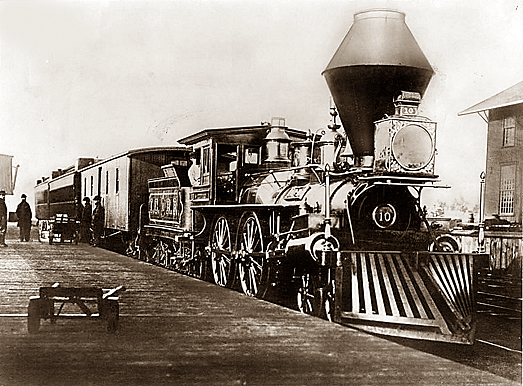
The first public railway which used only steam locomotives, all the
time, was Liverpool and Manchester Railway, built in 1830.
Passengers quickly took to the train in the following weeks,
attracted by the fact that the journey took just a couple of hours,
less than half the time it took in a stagecoach. Previous lines had
been open to fee-paying passengers, but within a short period the
Liverpool & Manchester Railway was primarily a passenger service –
and the first to rely solely on steam locomotion.
For the first time a double-tracked, steam-powered railway hauled
passengers and goods between two major cities. As the world awoke to
read reports of this pioneering achievement in the north-west of
England, the railway age was born.
The Steam Locomotive Comes to
America
In 1827, the Baltimore and Ohio Railroad became the first U.S.
company granted a charter for transporting both passengers and
freight. However, the company struggled to produce a steam engine
capable of traveling over rough and uneven terrain, instead relying
on horse-drawn trains. Enter industrialist Peter Cooper: Cooper, who
not coincidentally owned extensive land holdings over the proposed
route of the railroad (the value of which would grow dramatically if
the railroad succeeded), offered to design and build just such an
engine. On August 28, 1830, Cooper’s engine, which he called the
“Tom Thumb,” was undergoing testing on B&O tracks near Baltimore
when a horse-drawn train pulled up alongside it and challenged
Cooper (and “Tom Thumb”) to a race. Cooper accepted, and the race
was on. The steam engine quickly roared into the lead, but when a
belt broke loose it was forced to retire, and the horse crossed the
finish line first. However, B&O executives, impressed with the
massive power and speed Cooper’s engine had proven capable of, made
the decision to convert their fledgling railroad to steam. And as a
result, the B&O became one of the most successful railways in the
United States.
